FergWorld : Travelogues & Photos : 2004-2005

By Ryan Ferguson, © 2001-2005
The journey of a pilot. If you find it interesting, read on. Note that the travelogues continue past the bottom of this page (there's a link to previous years.)
Note: This page started life, years ago now, as a place where I could chronicle some of my more interesting flights, but it has mutated into a flight diary of sorts. When I get a chance I intend to split the true 'Travelogues' and their associated photos away from the diary entries, which I will move to a 'Flight Log' section of the site (yet to be created.) Such is the growth of an organic site, I suppose. Thanks for your patience.
Gold Seal
12/20/05: On a cool December afternoon in Florida, I walked out of the Orlando FSDO sporting a couple of new certificates: my new Advanced Ground Instructor certificate, and a renewed flight instructor certificate, good for another two years. The CFI ticket is now replete with Gold Seal Certification. From the time I strolled in, to the time I left, I spent perhaps 30 minutes at Inspector Miller's desk. He simply accepted my FAA Form 8710-1s, typed up the certificates and I was on my way; no muss, no fuss.
It's certainly the simplest and easiest process I can remember, across umpteen practical exams and knowledge tests, involving the old 8710. The form itself brings back memories of hard work. When you turn in an 8710, it's usually the result of weeks or months of work; and the form itself is simply a precursor to a practical exam of some kind, which required advance study and preparation. In this case, not so.
Well, not exactly.
I did have to recommend at least ten applicants for checkrides (I'd done eighteen) and at least 80% needed to pass their practical exams on the first try. (My students had a combined 100% success rate; they were all quite good.) To prove it to the FAA, I'd turned in a stack of temporary airman certificates. Some of them, I'd kept in touch with; most, I had not. I wondered how they were faring since we'd spent time together.
Each name on the list brought back a memory defining the person. I remembered Catherine's enthusiasm and zeal working on her Helicopter Flight Instructor - Instrument Helicopter certificate. I recall her laughing at one of my dumber jokes while she flew a perfect hold under the hood, tracking across the ground at 27 knots with a thirty degree wind correction angle due to extreme winds.
Tim, a quiet British gentleman who had come from overseas to complete his FAA instrument rating in the Cirrus SR-22. Tim persevered over extreme adversity to complete his rating. He broke into tears when the DPE shook his hand and told him he'd passed.
Scott, a sharp young man who'd recently graduated from college to become an IT professional - I remember him taxiing around on his first solo; all full-stop landings. He kept forgetting to retract the flaps after he cleared the runway. But his smile from inside the cockpit was bright - brighter than the landing light which he'd also forgotten to turn off.
Keith, a doctor who earned his private pilot certificate after two years of being shuffled from instructor to outgoing instructor. Keith was a true kneeboard samurai. Even for a flight in the pattern, both legs were covered with multi-pocket kneeboards, and for good measure a bulky flip-book checklist rode on top of the "Ultimate Aviation Trapper Keeper."
Steve M., a tenacious soul who camped out at the flight school to earn his instrument helicopter rating, bound for Alaska as soon as the ink dried; for some reason I remember him complaining about my choice of restaurants for lunch.
Anthony, the goofy high-school-cum-university kid who might possibly be the very best stick and rudder pilot with whom I've ever flown. I'd told him not to let it go to his head, and he never has. He's a humble and incredibly talented pilot. It gives me great pride to see him develop and mature into a man. I'd worked with Anthony on multiple ratings.
Steve V., a soft-spoken and kind-hearted fellow who added an MEI onto his flight instructor certificate. You'd never guess he was a former race car driver.
Ivan, the FBI agent who I truly came to love and adore; he had a habit of trailing softly off to nothing in the midst of a radio transmission, leaving the controller wondering if his receiver had just faded out.
Demetri, the Russian pilot who was so forceful with his control inputs in the air that he left me feeling sore and bruised, but squeaked on the sweetest three-point and wheel landings you ever saw.
Mike, the guy who flew once and only once, but who cackled with glee when he pulled aft on the yoke, and the wheels broke free of the runway.
Nick, the mechanic who sat with me in the Schweizer on a maintenance flight; with a death grip on the canopy and wearing a horrified expression, he endured auto after auto with me to return re-rigged helicopters to service.
There were many more that came to mind as I thought back over the last few years; people I'd flown with for tailwheel endorsements, aerobatic instruction, BFRs, IPCs, discovery flights, the whole gamut. Every one of them taught me something valuable in our time together.
I also recalled sweating out the last minute preparations for a practical exam. I can honestly say I never recommended anyone who I felt had a reasonable chance of failing the test, but brain farts are always possible and even skilled pilots have bad days. But this cadre of students was a really good bunch. I knew they'd find success in whatever it was that they sought, whether it be an aviation career or anything else.
That simple list of names, dates, and checkrides I had prepared for the FSDO belied the enormous effort that these students - and I - had undergone to complete their training. I had casually flipped it up on the desk. Inspector Miller gave it a cursory glance, nodded, and handed it back.
Somehow, it seemed strange that the Gold Seal was both the easiest - and the hardest - "rating" I'd ever earned.
It's All About The Seat
11/28/05: I've enjoyed flying multiple flavors of Hawkers. The 700, in glass (aftermarket) and traditional instrumentation, and the 800XP in Honeywell and Collins (Pro Line 21) trim. All are fine aircraft. They are all comparable in basic capability, although the 800XP is a clear winner in takeoff performance, climb, cruise, and range. I've also spent time in the right seat of the Falcon 10 and Citation III. Those two are both real performers in the cruise speed category. Both will do .84 Mach or better, while the 800XP won't exceed .77 Mach except on a great day and low temps. The 700 usually won't crack .75, which is sort of pokey for a swept wing jet.
I'll tell you how much this matters to yours truly, the guy paid to ride up front: zilch. I don't get to choose where we go, and I'm not paid by the hour. I don't care how fast we go. It's all about the seat.
The Hawkers feature fully articulating seats with more "comfort controls" than you'd find in a Lexus. Check it - the pilot can recline, slide forward and aft, enjoy adjustable lumbar, translate vertically (nice for shorties), and adjust thigh support blocks between "tight" and "loose" (hard to describe). In addition, he/she may slide the rudder pedals fully forward and out of the way, and adjust both armrests vertically for that perfect long-range "slump" form factor all good professional pilots develop over time. The seats are covered with the typical heavy duty sheepskin, which is warm in the winter and soft in the summer. They're damn comfortable, thank you very much. They're obviously not built for snoozing, but you nearly could do so.
Everything else pales. The Beechjet, Citation III, and Falcon 10 feature some or no adjustment in one axis - fore and aft. It was quite disappointing the first time I flew the III, being used to the palacial flight deck offered by the 800XP. Had to go into squeeze mode to get situated, and then I couldn't get comfortable with the vertical seatback. Eeeyeck.
I am in for a serious letdown if I move into anything smaller than a Challenger.
A Perfect Day: "Florida beats Georgia... again!"
10/30/05: This is not flying related, per se. But, look at the top of the home page. See those two Gator emblems? That's a big part of my family's lives these days. Gator football games are a family event - we tailgate in style, and we have an outstanding time doing it. We bleed orange and blue.
On October 29, 2005, we attended the World's Largest Outdoor Cocktail Party to witness Florida's glorious 14-10 victory over our hated rival, the undefeated Georgia Bulldogs (at that time, ranked #4 and a potential longshot for the NCAA Nat'l Championship title game.) It was Florida's 14th win over the Poodles in 16 years (yes, you read that right.) Pardon me for a little trash talking, but prior to the game, the Georgia fans somehow get it in their head that they might win this particlar year. We were subject to verbal abuse from all sorts of misguided - and intoxicated - Georgia fans who thought this was 'their year.' You've really gotta wonder how those UGA fans do it. Year in, and year out, the planets align and the stars take focus, and in late October, Florida beats Georgia. It's the Way of Things, and to fight it is to fight the nature of the Universe itself. Just because we're accustomed to beating Georgia, and always expect to beat Georgia, doesn't take any of the sweetness out of the victory.
Here are your Mighty Florida Gators:
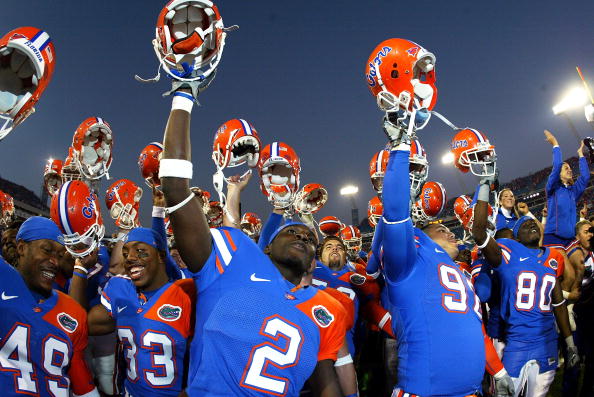
G
O
G
A
T
O
R
S
!
Babies, Upgrades, and 'Round the Horn
08/22/05: Whole lotta stuff going on these days. Almost two months since my Simuflite update? Seems like yesterday. Goodness, how time flies.
Most importantly, my son (second baby) was born on August 9th. His name is Robert Charles. He has very blonde hair, blue eyes, and weighed 10 lbs., 0 oz. when he was born (wow!) My wife and I feel very blessed to have another healthy child in our lives.
On to aviation matters. Upon my return from Simuflite, two good things happened. First, a right-seat slot opened up on our Hawker 800XP, and I was assigned that slot for my primary position. Second, I upgraded on the Hawker 700, and - after a company checkout flight - flew my first flight as "Captain Ferguson" (ha!). Let me tell you, I was grinning big that day. The first time a 25,500 pound jet is released to your care is something you'll always remember. Most of the company's members of management called to congratulate me after I touched down at my destination. I endured jokes about flat spots on the tires and stains on the seat as the customary ribbing a new captain gets. I now fill in as a reserve captain on the 700 when needed.
More about the 800XP. Look at this beauty:

And now look at the flight deck:
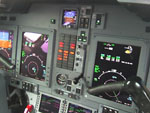 |
 |
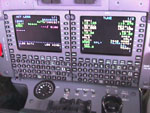 |
|
The panel. |
PFD. |
FMS. |
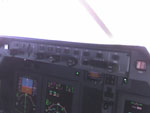 |
|
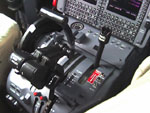 |
|
AP & Flight Director panel. |
|
Pedestal. |
This is a Collins ProLine 21 avionics package. This is what the Avidyne Entegra and Garmin G1000 GA packages want to be when they grow up. EVERYTHING is integrated; even the checklists. I occasionally look at an approach plate, but that's about it as far as paper goes. It's a dramatic departure from the 700's cockpit, which is equipped with totally traditional flight instrumentation.
The first picture, top left, is a good overview of the panel. The four main screens are really just two, duplicated for PIC and SIC. The PFD is the 'Primary Flight Display' and contains the basic flight instruments, plus a lot more. You can see on my PFD that we're doing Mach .76 at FL380. That's a typical cruise speed in the 800XP - anywhere from .76 up to .78. Not fast by Lear standards, but far more comfortable! The pilot seats are fully adjustable - the seat can tilt back, and there's even a lumbar control! It is far superior to other comparable jets in terms of comfort (that goes for both the flight deck and the cabin.) Also on that photo you can see the ESIS (which is the standby ADI in the center top of the panel), MWS (master warning system), and the two CDUs (you'll also hear them referred to as FMS) at the bottom center. The steam gauge in the center of the panel is the hydraulic pressure indicator. Although it looks like Darth Vader's bathroom the first time you step in and power it up, this truly is an extraordinarily easy way to control an aircraft once the user becomes accustomed to the system.
The MFD is the "Multifunction Display" and can be used for everything from navigation and radar displays to checklists. The MFD also contains fuel gauges and flap setting indicators (the semi-circular presentation with a yellow quadrant.) You can see the autopilot and flight direct control panel, and of course the pedestal, which is basically the same in every Hawker.
This airplane flies a lot, but it has a great schedule, much better than the 700; lots of day trips, very few weekends. (That's especially good going into college football season, as I fully expect Urban Meyer's Florida Gators to dominate the SEC, and I want to be in the Swamp to watch.) It's a true business aircraft flying the prototypical corporate missions (plus a lot of fishing trips.) Like everyone I've flown with at my company, the primary captain on this airplane is a great guy and very experienced in Hawkers. He has over 3,000 hours in many different HS125 models. I've learned a great deal flying with him.
The company tells me they're waiting for a Hawker to come online for me to call my own. Right now I'm not sure I'd be as excited about that as I would remaining right seat on the 800XP. I really love this schedule - I'm rarely away from home, yet I do a lot of flying (about 50 hours per month.) About half of that time is PIC. Not bad - a year ago I'd only flown in a jet once, now I get 25 turbojet PIC hours per month. How times change! Being assigned my own airplane is the natural progression of things, and I'm looking forward to that. If the schedule is anything like this 800XP's, I'll really be happy. But I've learned that schedule is the most important thing in this corporate pilot's career, and will guard this highly desirable schedule with great jealousy.
In other news, I'm finally buckling down to wrap up my helicopter ATP add-on. I took the ATP-RH written at the same time I took my fixed-wing ATP written, and those tests do expire after a couple of years; I figure if I don't do it now, I'll never do it. So I'm working with my former pupil Steve Copeland at Air Orlando to knock out the ATP. Steve has become an accomplished and experienced helo instructor, so I'll probably learn a few things flying with him. I haven't flown a piston helicopter since March of '05, so it ought to be interesting. I hope I'll have the rating finished in the next week or two.
Speaking of expired tests, I took an AGI (Advanced Ground Instructor) written test many moons ago, when I took my CFI writtens. I never turned it in for an AGI certificate and it has expired. Now, I'd like to renew my CFI by showing my 100% pass rate over the last few years - it's a 100% pass rate for 21 student checkrides ranging from private pilot airplane to CFII helicopter. I'm quite proud of that accomplishment, actually! To get my Gold Seal on my CFI certificate, I need the AGI. Sigh. That means I have to take that written again, which I'll also do this week sometime.
And with that, I believe the update is complete. Stay in touch.
Simuflite & the HS-125 type rating
06/23/05: After a 16-day stint away from home, I'm back with a fresh temporary airman certificate. It reads:
AIRLINE TRANSPORT PILOT
AIRPLANE MULTIENGINE LAND
HS-125
COMMERCIAL PRIVILEGES
AIRPLANE SINGLE ENGINE LAND; ROTORCRAFT - HELICOPTER;
INSTRUMENT - HELICOPTER |
Simuflite was a great experience. I was grateful for the opportunity afforded to me by my company to earn the HS-125 type rating on their dime. Heck, they paid me to go!
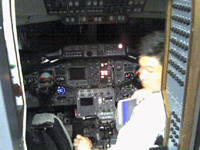
I kept a journal (including pictures) which outlines some of my more memorable Simuflite experiences. Click here to read it.
Hawker
05/27/05: I love flying this thing.
Thanks to a GREAT captain who's been giving me tons of flying time, I've got a bunch of T/Os and landings under my belt, approaches, steep turns, etc. With about 40 hours in the HS125-700 now (wow, that was fast) I feel pretty comfortable. Flying a jet really is a simple affair when you have a two-man crew and a solid ship like the Hawker.
I attend Simuflite in early June. Originally, the plan was to take the SIC course, which is essentially the same as the initial PIC course except for a few less sim sessions and no checkride. Now, however, the company has decided to type me in the airplane. So if all goes well, by the end of June I'll have an HS125 type rating on my ticket. Wow!
I've been flying nearly every day. In fact, today - Friday - is my first day off in two weeks. I enjoy getting the flight time, but I wouldn't mind having more time off to spend with my family! The definite downside to this career is being away from home many nights. I am testing my resolve with a "trial by fire," as with my Simuflite training I must commit to a one-year employment agreement.
I've been using the Twin Comanche to commute to and from work. The airplane has been incredibly reliable these last two years. My only squawk right now is a PTT that's flaked out. Not bad for a 40 year old twin!
More soon.
High-fidelity first class traveling set
05/03/05: What a month it's been.
First of all, I've moved my family from one house in Orlando to another. Second, I've been flying my hind end off.
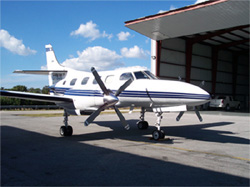
Merlin IIIB. Two TPE 331-10U-512Gs put out a combined 1800shp (continuous.) |
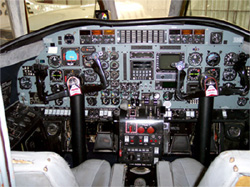
The panel. Nothing fancy here; monochrome weather radar, Collins APS-80T autopilot.
|
Notable stuff: as of my most recent flight in the Merlin (yesterday), I'm "signed off" to take the airplane as PIC. We don't use the whole "captain" and "first officer" terminology at my company. To our passengers and customers, we're technically either a "captain" or a "co-captain." This is all part 91 stuff; none of us pilots really care. The Merlin IIIB is a single-pilot airplane, so technically the second pilot (we take one on the Merlins due to insurance requirements) is just hanging around enjoying the ride. Having two pilots aboard is definitely a Good Thing, though, to keep the workload down. (There are very few differences between the III and its big brother, the Metroliner, which requires a PIC with a type rating and an SIC.) However, it's really gratifying to know that the company trusts me with their monster turboprop hair-on-fire-screaming-roller-coaster airplane. Heckuva lotta fun to fly - I love it.
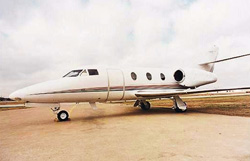
Dassault Falcon 10. Sleek, capable machine. |
I've also been flying right seat in a Falcon 10 for the last few weeks. I had my 61.55 check plus about four legs flying the ship. The Falcon 10 is a sweet flying jet which is very easy to fly. Leading edge slats are a great feature to improve low-speed handling and short-field capability. This is a relatively simple jet - there's no APU and the systems are straightforward. Perhaps best of all for hamfisted n00b jet jocks like me is the trailing link landing gear. I've yet to make a landing in this airplane which draws a customer's ire! But I can't take any credit, it's all in the gear. Wish they were all made like that. I've really had a lot of fun in the Falcon.
I've had a bit of a mini-drama with my airplane assignment. As you might have read in an earlier update, I was initially assigned the Challenger 600-1A11. Great equipment, absolutely drop-dead gorgeous ship with some nice gadgets for an '83 CL. I loved the idea of flying that bad boy. But, I had reservations about the aircraft's base (a 3 hour drive from home) and the length of its typical trips. Being a family man these days, a greater number of shorter trips appeals more than a fewer number of longer trips. The Challenger (and its customers) fits in the latter category. Frankly, I was very nervous about how my lifestyle would fit into the mix. The company saw fit to address my concerns: I learned last week that I was being reassigned to the Hawker 700 as my "permanent" airplane. In fact, I go to Simuflite next month for initial training - a 10 day "drink through a firehose" training experience.
To say that I was relieved was an understatement. The Hawker's a great airplane based much closer to home, and it's not likely to be gone for more than 4-5 days at a time. Even better, it's a "multiple leg" airplane meaning that more of those days away from home will be spent flying. I'm incredibly excited about this gig.
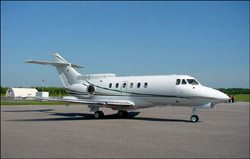
Hawker 700B. |
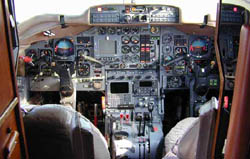
Hawker 700 panel. "If it's not British, it's crap!"
|
I took my 61.55 SIC check today and also flew a short customer pickup trip in the airplane. What a GREAT bird! My takeoffs and landings went well. I'd been studying systems and procedures at home prior to the check and found everything as I'd expected. A good friend of mine flies Hawker 800XPs for Flight Options, and has something like 2,300 hours in Hawkers of various vintages. He's been a treasure trove of information for me. (Thanks, Mike.)
There are some interesting idiosyncracies with the machine. First of all, it's a British airplane (made by British Aerospace) so you'll find some odd terminology. For example, they're not "bleed air valves," they're "main air valves." The electrical system uses an odd array of numbers and letters to identify the various buses. Also, the Hawker 700 is equipped with a TKS weeping wing de-ice system - no hot wings here, although the TKS reportedly works quite well. One of the better innovations is "Lift Dump," which allows the pilot to drop the flaps to 75 degrees for incredibly effective braking on the rollout (nearly negating the need for thrust reversers, although this particular Hawker does have T/Rs installed.) However, although it's an outstanding performer in almost every department, it has some issues with runway length. Basically, it's a pavement hog. 4,500 feet is on the short side for a mid-weight load Hawker. (Max gross is 25,500 lbs.) Fully loaded? High density altittude? Better find a loooong runway.
And there you have it. I've been flying with some great pilots who have lots of experience in many segments of professional aviation. I've learned so much in the short five months I've been on the job. I feel very fortunate to be in a position to learn and and profit from their knowledge.
As the MickeyD's commercial goes, "I'm lovin' it." More updates soon...
New addition
03/22/05: Yep, you must've noticed 'em by now. I've signed up for Google's AdSense program. First time in... well, ever, that Fergworld.com has run ads. Heck, the domain name gives it away -- I was NOT trying to set any records when I created this site. It's just a personal aviation site (nowadays they call them 'blogs,' I suppose) that keeps getting bigger and bigger. (When I transferred this site to a new server a couple of weeks ago, I discovered that all of the content on this site totals 300 megabytes! Jeez!)
But, traffic here is up... way up. There are more than a few of you out there that read this site, I've come to realize. In fact right now we're averaging over 4,000 unique visitors per month, with 18,000 pages viewed, and, well, frankly that's pretty darn good for a homegrown green tomato like Fergworld. It's also creating more of a demand on my resources to keep the site up and running. I'd be lying through my teeth if I said this was anything close to a chore - I really enjoy interacting with aviation enthusiasts, and I'll keep doing this for "free" for a long time to come. I have no intentions of changing anything at all; in fact I want to keep making the site better.
So these little ads, if you've noticed, are all text, and they're relevant. I've peppered them around the content areas of the site as tastefully as possible. I made the decision to add them based on the fact they're relatively unobtrusive and pertinent to my subject matter. I've been a pretty big fan of Google's product line since the search engine was first introduced. I use Gmail, Google Maps, Picasa, you name it. I figured if anyone knew how to do this right, it'd be the big "G," so I'm giving them a shot.
So I'm asking ya'll, if you enjoy this site and would like to see to it that it keeps soldiering on into the future, to please take the time to check out a few links that might be of interest to you when you visit. If you don't have the time or inclination, no problem. Enjoy your stay and browse the site to your heart's content.
Thanks to every one of you for making this work-in-progress such a pleasure and privilege for me. I am truly honored and humbled.
-Ryan Ferguson, ATP/CFII/HTML jockey
... your day job?
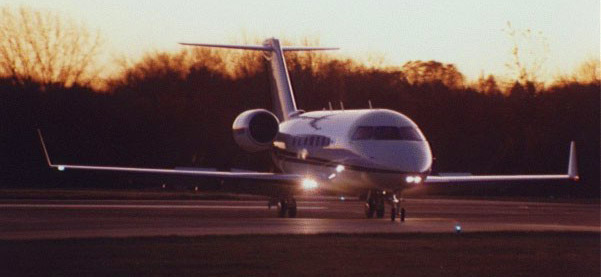
Challenger CL-600-1A11
3/16/05: I've received a couple of emails lately that go something along the lines of: "So it looks like you're flying helicopters for a living, now?" Sure enough, the last three entries in my 'logue are rotor-related. To answer the question, no, helicopters are only a very small part of the flying I've been doing since I moved on from flight instructing.
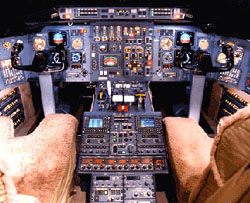 I've been a floater pilot for a Florida-based company which operates a wide variety of aircraft, including helicopters, twin turboprops, and jets. I'm being intentionally vague because I don't ever intend to reveal the name of my employers, the identities of the passengers I fly, and so on. This is out of respect for their privacy, and the specifics don't really matter, anyway. But so far, it's been a good experience, and I've learned quite a bit.
I've been a floater pilot for a Florida-based company which operates a wide variety of aircraft, including helicopters, twin turboprops, and jets. I'm being intentionally vague because I don't ever intend to reveal the name of my employers, the identities of the passengers I fly, and so on. This is out of respect for their privacy, and the specifics don't really matter, anyway. But so far, it's been a good experience, and I've learned quite a bit.
Most of my time has been in two different kerosene burners - a King Air C90 and a Merlin IIIB. The King Air is an incredibly simple aircraft. Sure, there are some minor systems complexities above your typical piston twin - pressurization, turbine operation, and some minor systems management funkiness. But for the most part, if you can fly a Seneca or a Baron, the King Air is no more difficult to handle in both normal and abnormal flight modes. It's just a lot quieter and a little faster (but not much - it's about a 200 knot airplane.)
Now, the Merlin on the other hand, is without a doubt the beastliest twin turboprop I've yet flown. This thing cruises at an impressive 270-280 KTAS, features a very 'interesting' electrical schematic, and a number of, ah, "unusual" systems. It's not the easiest ship to land well, it sits quite tall on its gear, and is equipped with direct-drive Garretts (TPE 331-10U-512Gs, if you're interested) which are not quite so simple to manage as the King Air's indestructible Pratt & Whitney PT-6A-21s.
I greatly enjoy flying the Merlin. The BE-90 is fun, too, but there's not a King Air flying that won't be forced to eat the Merlin's wake in a horse race. That goes for any King Air, including the 200. So can you tell which airplane I like better?
I learned a few weeks ago that I had been assigned the Challenger CL-600-1A11 for my "permanent" airplane (see above.) I was very excited (and am still very excited) about the prospect of flying the Challenger, but I've since voiced some concerns about being based in an airplane which is located nearly 180 miles away from where I live. There are other airplanes located geographically closer to my home in Orlando, so I've "floated" the idea of maybe being reassigned to one of those. As of right now, the issue is unresolved, but I suspect I'm going to be flying the Challenger. Either way, I'll be happy to fly whatever I'm given. The airplane is in the process of getting a completely revamped interior and some avionics upgrades - it'll be another 6-8 weeks before it's ready to go, so I'll be floating around on other airplanes until then.
I'm hoping to create new entries in the "Airplanes" section of my site which provide detail on the Merlin, C90, and Hughes 500. Keep on the lookout for those.
Stay in touch, everyone!
Flying Across the Third World in a Hughes 500
Route:
SFB -> LAL -> FXE -> MYNN -> MYEF -> MBPV -> MDPP -> MDPC -> TJSJ
Aircraft: Hughes 500 (OH-6A)
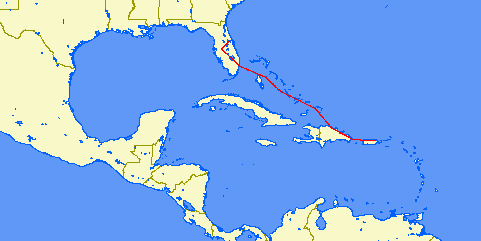
Great circle route courtesy Great Circle Mapper
3/9/05: The mission was simple. "I have a Hughes 500 that needs delivery to Puerto Rico," Mike wrote in an email. "Interested?"
Seeing as how I'd been trying to pick up more (okay, ANY) local contract helicopter gigs for some time, my answer was along the lines of, "Is the Pope Catholic?"
I flew two checkout flights, both of which were highly interesting/educational, and was turned loose with the helicopter. I flew it home to Sanford so that I could leave at the crack of dawn on the day of my departure, without first having to drive to south Florida to pick up the ship. Yes, I wore a fierce grin all the way home.
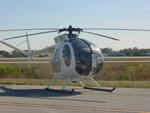
The ship - converted to security detail. |
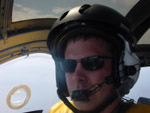
Dat's me. |
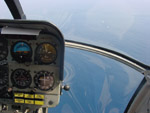
Whole lotta water to cross - leg 1. |
It's not the fastest ship around, but cruising at 105-110 KIAS is a lot faster my trusty Schweizers. It's also slippery in the extreme, which means that approaches must be flown with more pre-planning in mind. Most important, I'd learned from my checkout flights, was to keep the ship's speed in check. Approaches are best flown in airplane-like fashion - long, gentle descents. And tailrotor effectiveness is limited at best; I learned the importance of approaching the pad into the wind when flying a Hughes 500.
Considering I'd be flying nearly 1,000 miles, most of it over the ocean, I had a few things to prove out with the helicopter prior to departure. First, and in my mind, most important, was the fuel system. This OH-6A wears an Allison 250-C18, rated at 317shp, which sucks down anywhere from 21-28 gallons of Jet A per hour. (The gauge is measured in pounds, but I've found when you're dealing with such small amounts of fuel on board, it's easier just to stick with gallons.) The fuel is split between a belly tank containing 352 pounds (sigh... about 53 gallons, give or take) and an auxiliary tank mounted underneath the rear passenger seats - capacity 19 gallons.
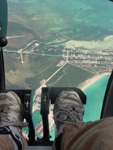
Feet dry - crossing Bimini. A brief reprieve. |
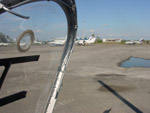
Ready to clear Customs - Nassau. |

Nassau ahead. |
The turbine will only draw from the belly tank. After 60 to 90 minutes of flying, it's safe to begin pumping fuel from the aux tank to the belly tank. This is accomplished via two transfer pumps, which draw fuel from the aux tank and dump it directly into the filler neck for the belly tank. The obvious advantage to this system is the ability to inspect and verify operation on the ground, prior to flight.
It takes about 20 minutes to transfer the contents of the full auxiliary tank into the belly tank. If the transfer is initiated when the belly tank hasn't been depleted of at least 19 gallons of fuel, the pilot runs the risk of pumping the fuel overboard via a fuel drain on the belly.
No big deal. It all seemed to work well, and the helicopter felt "good."
Now, how to plan such a flight? Well, there's one, and only one planning resource which is absolutely necessary to fly a fuel and range limited helicopter on an island-hopping route to Puerto Rico. I'm talking about the 2005 Bahamas & Caribbean Pilot's Guide, produced by Pilot Publishing. This is a superb product and I can't overemphasize how important a role it played in my successful flight.
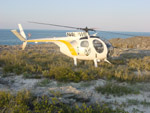
Landing on deserted islands... |
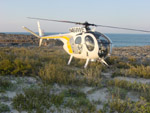
... in the midle of the ocean... |
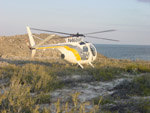
... is a perk of helicopter flying. |
Challenge #1 - the range. I decided not to exceed 220nm legs based on my fuel endurance. This proved to be almost exactly the right number.
Challenge #2 - the route. Right away, I discovered that Jet A was not readily available at most island airports. It quickly became obvious that when I was faced with a tradeoff choosing between a wetter route vs. a longer stretch, it was best to take the shorter leg and deal with the increased saltwater exposure. Of course, calling ahead and verifying fuel availability was an important part of the process. I also wasn't sure exactly how far I'd make it on my first day of travel, because I didn't know how much time to write off to Customs/Immigration and other such hassles. I decided my goal for Day 1 would be to reach Providenciales International. This later proved to be overly ambitious.
Challenge #3 - the gear. I'm accustomed to two engines in most aircraft I fly for any reasonable distance. As such my survival gear was pretty inadequate for an oceanic flight. I secured a couple of Mae Wests, and decided to stock my flight suit with a handheld transceiver (double-bagged in Ziplocs, for water protection), various snacks (survival food), flashlights, and important paperwork. Water was the most important concern. I decided I'd stuff a few bottles of water into my flight suit prior to each overwater leg. (This also proved to be overly ambitious - in the end, I just kept them on the front seat and hoped to be able to grab them when I exited the helicopter. Keeping them in my flight suit for hours on end was just too uncomfortable.) My MSA Gallet helmet came along for the ride, although I quickly ditched the uncomfortable hush kit (earplugs).
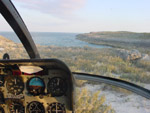
View from the break room. (Stop for a drink) |

Very relaxing. |
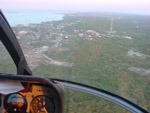
Over Exuma proper. |
By far the most important piece of gear, in my mind, was the handheld transceiver. It was my trusty IC-A23, which I've had for a few years now. (Read the PIREP here.)
I arranged to have a raft along with me, but at the last minute this option fell through. Unfortunately, I didn't have a backup for this contingency, and I'm sorry to say I flew this trip raftless. Good thing I didn't need to use it!
When the day of departure arrived, I found that the pilot's side door had a latch which had worked its way out of the door. I stopped at home base to have the helicopter repaired, which took a lot longer than originally expected (about two hours.) As a result, I had a much later start to my trip.
I made my way down to Ft. Lauderdale Executive for my final fill-up before heading out to sea. I confess that it felt a bit odd to watch the shoreline slowly fade out of sight from the cockpit of a single-engine helicopter. It wasn't an entirely comfortable feeling, to say the least. But I put those thoughts (sharks, and squalls, and drowning, oh my!) under lock and key for good as I made my way to Nassau via Bimini, then direct.
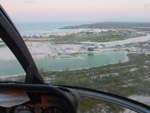
More of the Exumas. |
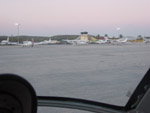
On the ramp at Exuma - just before sunset.
(Night flight in helicopters is prohibited in the Bahamas.) |
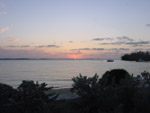
Sunrise from my hotel room in Exuma. |
I've been to various islands in the Bahamas before, both as a flight instructor and in service as jet/turboprop F/O. Customs in the Bahamas is a fairly simple process. You fill out an Inward/Outward Declaration, an Arrival Report, and pay a little fee. If you then want to fly to other islands, you must get a "Cruising Permit" which is another short form. It seems some folks are nervous about doing this for the first time, but it really is an absurdly simple thing to do, and trust me, the Bahamians love it when Americans visit their islands. You're not likely to find any unfriendly folks there.
Time to get out of Nassau. Due to my late departure time, I figured I was unlikely to make it past Exuma. I called ahead to check on hotel availability, found one with air conditioning, and launched.
This was undoubtedly the coolest leg of the entire trip. The Exumas are a long chain of tiny, uninhabited islands, with an actual landmass at the southeastern tip of the chain. Although much of the other legs were flown at 3,500 to 5,500 feet, I couldn't resist flying the chain at about 50 feet, twisting and streaking among the waves and rocks. As Gene Cernan said when he flew the first low-altitude moon orbit in Apollo 10, "We is down and among 'em, Charlie!"
The next morning I launched for Providenciales - "Provo," as everyone calls it - in the Caicos. My first run-in with Customs Goons - fees (including "Her Majesty's Customs Handling Tax," or something to that effect) exceeded the cost of fuel (which was $4.00/gallon.) Although it wasn't my money being spent, I couldn't help but feel frustrated at this extortion. But any such indigestion was largely academic - there was nowhere else within range to get fuel. Painted on the FBO's hangar door: "PROVO'S ONLY FBO!" Something to be proud of, I suppose - they may not be the best, but they're the only game in town. You do business by their terms. At least they were friendly.
Next up was the big D.R., the Dominican Republic. The D.R. comprises a little more than half of the landmass. On the western side you'll find Haiti. Haiti's a scary place to go. I made sure to stay well east of the border and landed at Puerto Plata, on the north coast. The D.R. loomed out of the haze as a lush, green, mountainous country. The airport was beautiful, although the controller's poor English made finding the GA ramp (it's hidden behind the International airline terminal) difficult. After shutdown, I found extortion fees were up 100% from Provo. My cash reserves were dwindling - friendly Emmanuel wanted the Handling Fee in cash only. "Can I pay you with credit card?" I asked. (The fueler had already refused the credit card, also.) "It would be better for you, seņor, if you paid cash," replied my friendly little buddy, his incredibly white teeth gleaming in the sun. Message received and understood. I was down to a few bucks cash, and I still had another stop in the D.R. I was headed to Punta Cana, on the east coast of the island. Emmanuel promised to call ahead and make sure Customs would be waiting for me, and to ask a personal favor from his colleague "Margarita" to process my handling fee with the copter's owner's Amex.)
This was probably just as good as the Exumas leg, but I'd still rank it second place simply because I had such a difficult time with communications. It seems that transmitters in the D.R. are of fairly low quality, and the controllers' heavily accented English made every transmission a tiring exercise. However, once I'd filed my flight plan and checked in with Santa Domingo Information, I was free to get to Punta Cana VFR however I pleased. Trivia note: all IFR and VFR traffic in the D.R. is handled on completely separate frequencies and controllers. Trivia note 2: there's no radar in the D.R., so you're asked to please "be honest" about your altitude reports and remain vigilant for other traffic. We really have it good here in the U.S. Our ATC services are magnificent.
Another low altitude hop, a very beautiful one, as I frequently flew low through mountain passes and occasionally sidestepped to the northern coastline. I also saw poverty from a fairly low altitude, and that was sad to see, but the beautiful countryside kept my attention more often than not.
To the best of my knowledge, no one took a shot at the helicopter.
And on to Punta Cana. Ah, Punta Cana. This stop will remain etched in my mind because things got a little tense, and my negotiation skills were called into play. I was marshaled onto a special ramp upon my arrival - ah, sweet Emmanuel, thank you, my friend, for your help. The sun was starting to fade, and although I was only a short, wet hop from San Juan, I did not care to make the crossing at night. On the other hand, I did not care to stay here in the D.R., either, so the only way to make this work was a quick turn at MDPC.
The fueler arrived. He didn't speak English, but shook his head at the words "Credit Card." He said only one thing: "Cash." He stared mutely into the distance as I tried to come up with a solution. Next on deck was Customs. Margarita was absent, but a couple of friendly goons arrived in her stead in an attempt to draw cash out of me. To cut a long story short, I ended up departing Punta Cana with enough sunlight to make the crossing to Puerto Rico, but the "Fee" doubled to $350. And the fuel wasn't cheap. I made the mistake of complaining how I had only eight dollars cash remaining in my wallet, and was promptly served with a separate ramp handling fee invoice. You guessed it - $8.00, due in cash only. Sigh.
Finally, Puerto Rico - a US territory. While Customs is a joke in all of the aforementioned countries, United States Customs and Immigration takes their job very, very seriously. I spent two hours attempting to clear, primarily because of the unusual nature of my arrival, I'd reckon.
The next morning, bright and early, I boarded an American Airlines 757, reversed course, and was back in Orlando a few short hours later. Success!
Ed. note: I will add more pictures soon.
Tailrotor failure - a helo pilot's worst nightmare
 3/5/05: Out of all the potential emergencies in all categories of aircraft that I currently fly, one clearly takes the cake as "the worst of the worst" in my mind.
3/5/05: Out of all the potential emergencies in all categories of aircraft that I currently fly, one clearly takes the cake as "the worst of the worst" in my mind.
Tail rotor failure. (Ya'll who fly airplanes only ain't ever seen nuthin' like this. Take bad, multiply by ten, then soak it in Barry Bonds' favorite skin cream.)
Yesterday, my fellow instructor -- and former student -- experienced exactly that over busy downtown Orlando.
At 800 ft. AGL, student on the controls, Steve heard: "Bzzzzzz." A split second later: "Bzzzz-rrrrrrRRRRRRRROAAAAAR!"
The roar did not abate. The helicopter began an uncommanded yaw to the right. Power lines, buildings, traffic, and people waited below. Steve took the controls and had a quick decision to make: conventional thinking with this sort of failure is to "nurse" the ship to a clear area and perform a running landing (which is basically an approximation of an airplane landing, with the helicopter "running on" to the ground, sliding on its skids. The pilot then uses throttle to control heading; in American-built helicopters, increasing throttle yaws right, and decreasing throttle yaws left.)
Sitting two feet in front of a splineless tailrotor driveshaft, the noise was terrifying. Steve knew he'd lost his T/R, but didn't know what else had occurred, didn't know if his window of powered flight was in the process of closing. He made a command decision to begin an autorotation and accept what lay below.
As fate would have it (and thank goodness fate can be kind, sometimes,) a parking lot was nicely available just a few degrees off the nose. Steve lowered the collective and rolled off throttle, as he'd done countless times before in training, and fruitlessly applied right pedal to counteract the onset of transmission drag. Muscle memory in cases like these can be an unstoppable force, so although he knew the pedal input was useless, he floored the pedal anyway.
These things happen pretty fast. Maybe 15 seconds later, Steve was pitching aft as he began his flare 30 feet above the ground. Worried about a concrete barrier directly ahead, he felt it better to accept a hard vertical drop after an aggressive flare rather than float into the obstacle. ("I flared the **** out of it," he told me later.) With the application of collective (torque,) the sans-T/R helicopter obeyed the laws of physics and began turning rapidly to the right. Amazingly, Steve held on to put the helicopter perfectly on the ground - no sliding, no roll. After a quick shutdown, both pilots hopped out of the helicopter unharmed. The ship was pointing nearly 90 degrees to the right of its final approach course.
Not a scratch on the helicopter. Not a scratch.
Although he probably didn't even realize it at the time, Steve was transmitting his mayday to tower throughout the fast-paced emergency. Channel 6's Longranger was on-scene just as Steve was touching down. Dan, a member of the ORL helicopter "fraternity" and known by all, whooped a shout as he watched Steve's handiwork in the parking lot. "WHOAH! Ha... This guy is the MAN! HE'S THE MAAAAAANNN! Somebody buy that guy a crate of beer... YEEEEHAW!" Transmitted right on frequency to the pride of us all.
Steve's a British fella. Unassuming, polite, friendly, funny. Everyone who meets him likes him immensely. He stood by the helicopter, smiled, and waved at Dan.
This morning, I had a look at the helicopter. All of the splines on the T/R driveshaft gear were reduced down to little nubs. Unbelievable. These helicopters are maintained to absolutely the highest standard, so a discrepancy related to ongoing mx seems very unlikely. (The only thing our shop does is inspect and lube, anyhow.) Our mechs perform 100 hour inspections ever 50 hours, and our 50 hour inspections are performed every 25 hours. Hopefully Schweizer will have some answers for us - metal analysis, perhaps.
I'm incredibly proud of my friend and former student, and I'm grateful he's walking around, laughing and smiling today.
Gooooo Steve-O!
Hughes 500
 3/2/05: I've got some upcoming work in this helicopter, so I completed a checkout today. This is actually a 369A / OH-6A, the "original." You won't find many folks referring to it as anything other than a 500, though. The US Army calls it the "Cayuse" and it was used as a target spotter in Vietnam. This particular helicopter has since been converted to civilian/police use. While it looks fabulous, it doesn't quite have the machismo of its successors. Usually you associate some level of power/speed with this airframe. However, with a derated T63-5A (equivalent to an Allison 250) on-board pumping out approximately 317shp, you're not going to set any speed records flying this ship. In fact I was cruising at less than 100 knots with 60% torque (which is just below the yellow arc on the torque meter.)
3/2/05: I've got some upcoming work in this helicopter, so I completed a checkout today. This is actually a 369A / OH-6A, the "original." You won't find many folks referring to it as anything other than a 500, though. The US Army calls it the "Cayuse" and it was used as a target spotter in Vietnam. This particular helicopter has since been converted to civilian/police use. While it looks fabulous, it doesn't quite have the machismo of its successors. Usually you associate some level of power/speed with this airframe. However, with a derated T63-5A (equivalent to an Allison 250) on-board pumping out approximately 317shp, you're not going to set any speed records flying this ship. In fact I was cruising at less than 100 knots with 60% torque (which is just below the yellow arc on the torque meter.)
Systems are very straightforward. It doesn't fly at all like a Bell 206, especially when it comes to stick force (it can require a fair amount) or trim (the motors run slow, and you need to "lead" the trim with stick force.)
This particular helicopter is equipped with an auxiliary tank which contains 19 US gallons, and which must be pumped into the main tank in flight. The procedure for doing this is straightforward. Fuel burn is 20-25gph, depending on how hard you work the powerplant.
More on this ship after I fly my first job. Enjoy the following pictures:
Seneca
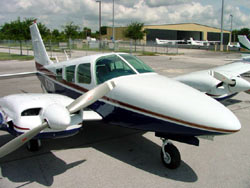 1/04/05: Although it's not something I've ever really written too much about on this website, one of the airplanes I've flown quite a bit over the past few years has been the Piper Seneca I. I've done some photo flights and sightseeing tours with the airplane - even a few trips to the Bahamas with students - but almost all of those hours have been earned the hard way - providing multiengine instruction of some kind.
1/04/05: Although it's not something I've ever really written too much about on this website, one of the airplanes I've flown quite a bit over the past few years has been the Piper Seneca I. I've done some photo flights and sightseeing tours with the airplane - even a few trips to the Bahamas with students - but almost all of those hours have been earned the hard way - providing multiengine instruction of some kind.
Actually, I enjoy multiengine instruction. It does require keeping your "instructor's edge" at all times, but almost without exception all of the pilots I've trained have been fun and easy to fly with. Good students make an instructor's job seem awfully easy.
After a four-month hiatus, Air Orlando finally returned to the multiengine rental/instruction business after Hurricane Charley (dreaded be thy name) destroyed both of our Senecas in September, 2004. Our new (to us) Seneca I is equipped with two overhauled IO-360s that purr like a kitten, a brand new interior, and an HSI. One of my favorite young pilots, Anthony, a hard-working "airport kid" whom I mentor, had been waiting for the return of the Seneca so he could add-on a multi-engine rating to his commercial pilot certificate. As soon as the airplane became available, we lined it out and planned to knock out his ME rating in about a week.
The next day, a fellow instructor asked if I'd be willing to work with him on getting his MEI ticket. I replied in the affirmative. Later that day, I was asked by two other instructors interested in doing the same thing. The next morning, I was asked again by yet another instructor. Wondering what the hell was going on, I asked, "Why me?"
"You're one of only two instructors left who can instruct in the Seneca," was the answer. So much for flattery. We've had a mass exodus of instructors moving on to the next level of their careers, myself included (although I'm sticking around part-time), and apparently the MEI ranks have really thinned! So I'm flying almost nothing but the Seneca for the next couple of weeks at Air Orlando. When it rains, it pours.
Frost Patrol
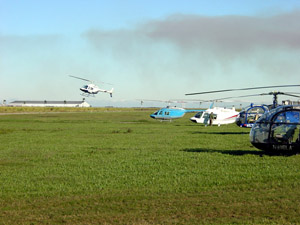 12/22/04: At eleven AM, I'm zipping down to Lakeland in the 206 with Markus. We meet with a motley crew - a half dozen or so other helicopter pilots. We brief the mission. How the hell does this work? Tom, a Scottish gentleman with experience at this sort of flying, explains.
12/22/04: At eleven AM, I'm zipping down to Lakeland in the 206 with Markus. We meet with a motley crew - a half dozen or so other helicopter pilots. We brief the mission. How the hell does this work? Tom, a Scottish gentleman with experience at this sort of flying, explains.
"On calm, cool nights, when the temperature gets down to zero or below, crops can freeze," he told us. "Our mission is to use the helicopter to draw the slightly warmer air above the inversion layer, which in this case is about 40 feet above the ground, and circulate it with the ever so slightly cooler air below it, thus preventing the plants from freezing."
In other words, frost prevention occurs not due to hot exhaust gasses (although they don't hurt), and not from compression of the air. It's JUST air circulation. 20-30 knots at 30-40 feet, and the air will keep moving. Of course, if the wind doesn't die down or if they temperatures don't drop as some think they might, we won't need to fly. But we'll be on standby directly next to the fields we're responsible for, nonetheless. The briefing concludes with hot-fueling procedures, air-to-air frequencies, accomodations, and most importantly, how to get our dinner. (Belle Glade ain't exactly a hopping place in the evening.)
Sounds simple enough. We caravan down to Belle Glade, a two-pack of Alouette IIs (which is my new favorite helicopter) and a three-pack of Bell Jetrangers. Belle Glade (X10) is just southeast of Florida's Lake Okeechobee, and is owned by local farmers. Several Turbine Thrushes are based at the field. (Man, those things are big when you stand next to them!) The local crop is sugarcane, although the field that Markus and I draw is yearling corn.
We have just enough light left to scout our fields for obstacles. This is a very important step, because at night the picture obviously changes quite a bit, and many obstacles become invisible. The Alouettes and Jetrangers lift and scatter radially around the aiport. The scene is very pretty as the deep orange light of sunset, and the position lights on each aircraft paint a view worthy of an IMAX movie. We're to be sharing one of the larger fields with one of the Alouettes. The pilot of that aircraft's name is "Nigel," a friendly British chap. We chat on the radio as we scan our field.
I notice that we have high lines on the east side of our square, a canal just inside of that, then low and almost invisible lines. We creep lower - there's a large tree in the center of the field which will be invisible at night, but we should pass just above it if we manage our altitude correctly. We elect to break the field into north/south halves, because neither of u wants to pull up over the power lines to drop back in for another run. Satisfied, we follow Nigel back to Belle Glade airport, slightly above and behind his black Alouette, now just a dark silhouette framed by position lights.
Watching a temperature alarm back at base, we never saw anything below 42 degrees, nor the did the wind die down. No need to fly this night, but we remain anyway, just in case, sacking out. Unable to get comfortable on the floor of the empty strip mall office we've been given, I trek back out to the helicopter and fall asleep in the back seat. Fun night - we'll do it again on Saturday.
Here are a few pictures I took. The 206 arriving in the pictures is the ship I fly. (We had already arrived at X10, and the 206 was being used to ferry pilots to have a look at their fields and to demonstrate the technique they should use to keep the fields warm without thrashing the crops.)
NOE Flight, Or, "Riding the Sky Train"
12/17/04: Unless you fly helicopters, I guarantee you've not flown a cross-country flight quite like this.
The Bell 206 which I have a chance to fly on a semi-regular basis (thanks, Markus!) needed to be flown from Lakeland, FL to Greenville, AL for a timber survey mission. Like all good helicopter pilots do, we carefully flight-planned the journey using our E6-Bs, numerous charts and publications, and the 206 AFM. Thanks to our diligent efforts and detailed calculations, we quickly discovered that the flight would have the highest D-Q (Delight Quotient) if we zipped up the west coast of Florida at an altitude of no greater than 10 feet. Tossing our nav logs and flight computers in the baggage compartment, we hopped in the Jetranger and fired up the Allison 250-C20. Perfect cool weather and endless blue skies were the fare for the day, and in no time flat we were out over the water, streaking northward towards the epicenter of the universe, a.k.a. Greenville, Alabama.
It didn't take long to notice a lone sandbar a mile or two out in the Gulf, which of course needed to be investigated further. Satisfied that our skids would fit, we put the helicopter down long enough to enjoy an odd view, one of ocean on all sides. Where's a camera when you need one? Resuming flight: felt more like one of those high speed racing boats. Looking down through the 206's chin windows, the waves rolling by under my feet reminded me of the 'Star Wars' streaking stars effect.
Seems the best way to travel a long distance over wide-open terrain with no sign of civilization around is to do it right down on the deck. Okay, maybe that's not the best way, but it's certainly the most fun. Tired? Want a drink out of the back? Land in a clearing and relax.
Getting a chance to do a few hover autos, some confined area approaches, and plenty of time on the controls left me feeling pretty comfortable with the Jetranger. I've crossed the sixty hour mark now and I feel this is by far the easiest helicopter I've yet flown. I greatly enjoy my opportunities to fly the machine and my next mission will be to join Markus flying frost patrol with 30 other helicopters in a few days. That's an all-night, 12-hour experience which will surely be exhausting but knocking down another dozen or so turbine hours will be well worth it. I am lucky to have such a good friend in Markus, who makes sure I keep getting time in his helicopter. Thanks, mang!
New horizons
11/06/04: One chapter has closed, and another has opened. My days of being a full-time flight instructor have ended. I've accepted an F/O job with a local charter operator. I'll be flying several airplanes - initially, the Citation 500 and Lear 35; followed by the Citation III; and ultimately, on a TBD timescale, the Falcon 50.
This job is a perfect fit for me. I'll be able to remain local, most of the trips are overnights or just a day or two, and I'll be around my wife, daughter, and extended family more so than I would if I chose to fly with a regional airline. It's the most logical step in my aviation career. I'm excited!
Hurricanes
10/06/04: A few days ago, I was in 'serving time' in Atlanta Hartfield's Concourse B, Gate 32 - at the extreme end of the concourse (where else?) requiring about a mile's walk with my bags - when I glanced up at a television monitor running CNN. My heart froze. I saw an all too familiar 2D map featuring oceans and a peninsula. The coastline was outlined in red - hurricane warning, no doubt! I almost spat an expletive out of sheer reflex when I noticed the peninsula was Japan, not Florida, and the 'red zones' were areas of US reconnaisance overflights... not areas of imminent hurricane landfall.
If you're a Floridian, you will completely understand that reaction. We're still a little on edge around here. Slowly, though, things are returning to normal.
Charley was our first tropical visitor. His quick but violent swath through my neck of the woods put a large tree in my parents' home, destroyed or damaged a third of Air Orlando's magnificent rental fleet, and demolished many buildings and airplanes at both Orlando Executive and Orlando Sanford airports. (My home airports!) Of course, we were all without power for some days. I didn't buy a generator... too much cash to spend for a few days of A/C.
That was also the closest I've come to losing my beloved Twin Comanche. I felt the airplane would be safe in its hangar at SFB. It was - barely. The hangar is comprised of two sliding doors, each weighing many hundreds (one thousand?) pounds. One door caved in and let the hurricane force winds in - but it didn't cave in all the way, and brushed up against the TwinCo's nose, leaving a 1" paint-scratch 'hurricane kiss.' No other damage. Had the airplane been parked just another inch or two forward, the nose cone would surely have been bashed in. Had the hangar door caved in completely, instead of getting caught up on the top outer track, the airplane would probably have been totaled. It spooked me.
Then came Frances. No question, I was flying the airplane out of town for this hurricane. I zipped it up to Rutherfordton, North Carolina, left my wife and baby there, and drove home in a rented Chevy blazer.
Oh. I stopped to buy a generator while I was up there, too. That turned out to be a very good call.
After Frances came Ivan. I refused to take a chance with Ivan and, yet again, drove the airplane up to North Carolina. This time I was lucky enough to catch a ride back with a buddy who flies charter in a P-Navajo. Sure beats the drive. Ivan ended up missing Central Florida, thankfully.
Jeanne appeared to ignore Florida completely, then decided to circle back and wallup us from hundreds of miles out in the Atlantic. Again I flew the airplane out, this time along with Air Orlando's fleet, to Columbus, Georgia. Another rental car drive home, this time earning my first speeding ticket in five years thanks to a half-blind Georgia cop. Jeanne gave us a pretty good beating and destroyed even more airplanes at ORL and SFB. She was supposed to turn east after scything up through Florida's gut, but of course she didn't, and 40 knot winds were forecast for Columbus, where the airplane was tied down (no hangars avaiable.) My good friend Eric McLeod came to the rescue, already being in the area ferrying AO's airplanes. The TwinCo was flown another 100 miles to the west, to Meridian, Mississippi.
After Jeanne, I caved in and purchased a commercial flight to Meridian (yes, Delta Connection has service there!) to retrieve the airplane for hopefully the last time. My hangar is still damaged, so the airplane has been spending its days outdoors for the better part of a month. However, all things considered I'm just happy the storm didn't cause us any more trouble than it did. My inconvenience and having to retrieve airplanes is wholly insignificant compared to the many who lost their lives, family members, and property.
Flooding is still fairly bad in Central Florida, but we're on the upswing. I've been flying a fair amount, but mostly Jetranger and Twin Comanche. Things have been a little slow on the instruction side, but people are slowly coming back to the airport and resuming their training. What a season it's been - I hope we never have another four hurricane year!
Citation II
7/31/04: I've always dreamed of flying a jet. Today, that dream became a reality. Here's the ship:
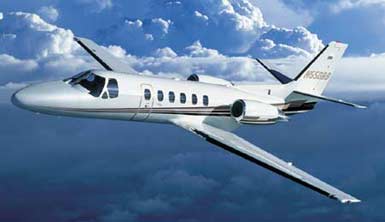
Cessna Citation II, the C550.

The instrument panel.
Okay, to say I flew it is overstating it a bit. In reality I flipped switches, organized approach plates and briefed some approaches, and smacked the flap lever around. It was still a blast to fly at FL330, and to act as SIC of a jet.
Initial impressions: honestly, the airplane seemed very easy and straightforward. There were a few bells and whistles I could not readily identify, but clearly this is not a complicated jet.
I had 3 hours to pepper the captain with questions on the quick round trip between ORL and AVL (Asheville, North Carolina, to pick up passengers.) The pressurization and environmental systems were very easy to understand; A/C on after start, turn it off passing through FL180 (fan only.) Keep the pressure differential below 8.8psi. The autopilot was no more complicated than the S-TEC 55X; save for some other modes on the altitude controller that were not immediately understandable, such as setting a vertical descent angle rather than rate (this was not used today.)
Weather at Asheville at time of arrival was 1 mile visibility with rain, ceilings 1900 broken. In reality the ceilings turned out to be closer to 500 broken, as we broke out just two hundred feet above minimums. Vref was 106 knots at approximately 12,500 lbs. The captain had the autopilot fly the approach, which I briefed and indicated 1000 ft. and 500 ft. above minimums. Oh, and I grabbed the flaps too, heh.
Maximum continuous takeoff thrust or maximum cruise thrust was set by a table on the checklist; the N1 setting is based on pressure altitude (S.L., 5,000, 10,000, 15,000, and 20,000+) and OAT. The captain was interested in keeping ITTs low since the engines were 70 hours away from hot section, so if the chart (which provides values for both anti-ice on and off) recommended 98.6 N1, we'd use around 96.6. ITTs were in the 600 range for both engines. There were no turbine (N2) tapes, just an LED readout of turbine output. No matter, power is set with N1 %RPM values.
FL330 is cool, and it's the first time I've seen it from the cockpit of a jet in which I was acting as a crewmember. However, the novelty quickly wears off and after a short time the view is no different than 10,000 feet, except you're ABOVE the weather, which is nice.
In cruise, our TAS was around 340, burning around 500 to 550 lbs. per hour. The airplane has a 4,970 lb. fuel capacity. We took half tanks on the way up and accepted an additional 300 lbs. per side for the return trip, which was with 4 passengers and a LOT of baggage!
Some odds and ends if you're interested: I asked about the boost pump switches, which I saw on the left side of the panel above the fuel selector. Essentially, they come on automatically in almost every conceivable scenario, which includes loss of fuel pressure (below 5psi), crossfeed, and engine start. The systems do seem fairly automated in a reasonably robust way.
On my side of the panel (see above photo, the panel of the ship I flew looked almost exactly like this save for a KMD550 multifunction diplay and a King KLN-90B) I had an ADI, HSI, and the full complement of flight instruments. I also had my own audio panel, which I needed help to figure out initially (some of the audio panel controls affect BOTH sides, even though each pilot has his own.)
I thought speed might be an issue (i.e., having a hard time keeping up) but the pace seemed very reasonable to me. I never felt behind the airplane or the situation. I noticed it helped to think in terms of minutes instead of miles. For example, we started briefing and preparing for the approach into Asheville while still 100nm out, at FL290, which seems like quite a distance if you're accustomed to 150ish knots, but that's less than 20 minutes' flight time in the Citation II. My comfort level was probably due to blasting around in the Cirrus SR-22 at 180 knots, and flying full power ILSs at close to 200! (Of course, that's not standard procedure in the Cirrus, but it's very doable.)
However, I say this with the benefit of simply flying a routine flight with no malfunctions or abnormals of any kind. The airplane may be an entirely different beast altogether when things start breaking or exploding!
New Private Pilot!
7/19/04: A belated congrats to Scott Millard, who started on the path of becoming a pilot years ago. Over years and many talks, and a few fun flights together, he and I finally made our instructor-student "relationship" official in September of 2003. In June Scott earned his Private Pilot certificate. You can read more about Scott's adventures here. He keeps a neat flying site of his own called IAmFlying.com.
I am proud of Scott not only for earning his Private Pilot certificate, but his good judgement and aeronautical decision-making abilities. He's a good pilot and I'd trust him to fly my family any day.
Jetranger
7/17/04: Thanks to my good friend Markus Siebert, I've been logging some time in a Bell 206 lately. It's been my first real turbine experience to speak of, and with about 4 hours in the machine now I'm starting to feel (slightly) more comfortable.
Starting a turbine is quite different from piston engines. In many respects it could be considered an easier process, especially compared to the fuel-injected Schweizer 300CBis I fly.
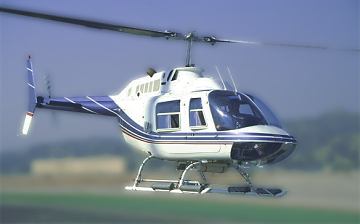 Heat management is a key issue in turbine operations. The starting procedure reflects this: master on, aft boost pump on, generator off. If the engine is warm from a previous flight, care must be taken not to "hot start" the engine by adding fuel (heat) until the TOT (turbine outlet temperature) is less than 150 degrees Celsius (typically, a flight made just prior will leave the engine at 300-350 degrees C.) To cool the engine down, the pilot verifies that the throttle is in the idle cut-off position and motors the starter button on the collective. The compressor stage (N1) starts to spin and draw cool air into the turbine, which rapidly reduces the temperature to an acceptable 150 degrees C. At 15% N1 (above 7 degrees Celsius ambient temperature) the pilot rolls the throttle past a detented cut-off position to introduce fuel, rolls right back to the idle stop, and monitors TOT. TOT rapidly climbs into the 700 degree F range, and care must be taken to roll the throttle to idle-cutoff if approx. 800 deg. F is exceeded. There are time limitations on operations above this range, but they are measured in seconds (approximately ten, if I recall, up to 927 degrees F.)
Heat management is a key issue in turbine operations. The starting procedure reflects this: master on, aft boost pump on, generator off. If the engine is warm from a previous flight, care must be taken not to "hot start" the engine by adding fuel (heat) until the TOT (turbine outlet temperature) is less than 150 degrees Celsius (typically, a flight made just prior will leave the engine at 300-350 degrees C.) To cool the engine down, the pilot verifies that the throttle is in the idle cut-off position and motors the starter button on the collective. The compressor stage (N1) starts to spin and draw cool air into the turbine, which rapidly reduces the temperature to an acceptable 150 degrees C. At 15% N1 (above 7 degrees Celsius ambient temperature) the pilot rolls the throttle past a detented cut-off position to introduce fuel, rolls right back to the idle stop, and monitors TOT. TOT rapidly climbs into the 700 degree F range, and care must be taken to roll the throttle to idle-cutoff if approx. 800 deg. F is exceeded. There are time limitations on operations above this range, but they are measured in seconds (approximately ten, if I recall, up to 927 degrees F.)
At this point N1 should be rising. Monitor and verify that the main rotor disc is turning by 25% N1, and that oil pressure is positive at 30%. At 58% N1 the starter button can be released, the throttle can be cracked, and N1 should stabilize at 61%. After running at idle speed for approximately one minute, throttle is smoothly rolled on to 70% on the gas producer gauge, the generator and forward boost bump come on, as well as power to the ADI, lights, and avionics. Now the pilot is free to roll on throttle to increase rotor RPM to 100%. To do this, he must make sure not to exceed approximately 30% torque, which is constantly fluctuating based on the amount of acceleration to the disc at that time. Roll on a little throttle, wait, and the needle settles at 30%, starts dropping, and roll on a little more. Eventually 100% RPM will be reached. A small governor increment switch on the collective allows the pilot to make minute adjustments to RPM if full throttle is not indicating 100% RPM, but this needs to be adjusted only rarely. Engine anti-ice should be activated under 4 degrees C and in visible moisture.
From this point on the helicopter flies pretty similarly to the little buggers I've flown to date. Things that are new: being sure not to overtorque the helicopter. It's possible to do, because you have more power than you can safely use in some sitations. An example of this would be a hot day, heavy load, and perhaps lifting without the benefit of the wind. Occasionally it may be necessary to divert some power from the tail rotor to the main disc by applying some right pedal, and accepting the yaw during the lift.
It's a very smooth ride, much smoother than the piston chatterboxes (ha!) that I drive on a daily basis. Actually the Schweizers are very smooth piston helicopters, but there's really no comparison to a turbine-powered helicopter like the Jetranger.
The hydraulics take a little while to get accustomed to. My inputs during my first flight were just slightly out of phase with the helicopter because I am used to the instantaneous response of the Schweizer.
It's also very fast - last night we cruised at 110-115 knots, faster than many single-engine airplanes. What a great helicopter, and I'm enjoying the heck out of flying it. Right now the hope is that I may be able to sit reserve to fly this helicopter, so I am being checked out on a periodic basis to be able to do that. Keeping my fingers crossed!
Syracuse
7/16/04: Spent a fun week up in Syracuse, NY providing transition training in a 2001 Cirrus SR-20. Here are some photos I took on the trip. It was a lot of fun watching the 174th ANG, the "Boys from Syracuse" light up the burners in their F-16s as they departed for numerous hops each day.
ATP
7/09/04: I suspect that, when I look back on it, the pursuit of the ATP certificate will comprise some of the most satisfying flying I have done. I really savored every flight, and every evening of study towards earning the ticket.
While I would not call it an easy certificate to earn, it was not necessarily difficult, either. The tasks were exactly as described in the Practical Test Standards, and thanks to my friends and highly proficient pilots Eric McLeod and Brandon Bryant, I was well-prepared for the flight. I had a particular advantage in the oral portion, thanks to my familiarity with my Twin Comanche. (The oral is essentially a series of questions on the systems of the checkride aircraft.)
While I do not expect to ever need the single-engine rating on the ATP certificate, getting it now will be relatively easy due to my preparations for the multi-engine ATP. As a result, I am digging in for the single-engine rating now.
The ATP PTS does not contain a rating task table, i.e. in the style of the instrument or commercial single/multi PTS. Every ATP ride is thorough and complete from start to finish. I'll do the approaches and air work all over again, just in a single-engine airplane (probably a Cessna 172 for convenience, since I'm pretty familiar with the systems of that airplane.)
And on that note, I'm off to Syracuse, NY, for a Cirrus training gig. I am looking forward to some cooler weather - the Florida summer heat is cooking me to a crisp!
Cool pilot getaway
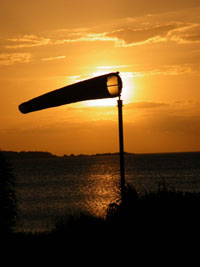 7/06/04: Looking for a really cool flying vacation getaway? Here's one that's hard to beat.
7/06/04: Looking for a really cool flying vacation getaway? Here's one that's hard to beat.
Next time you go on vacation to Florida, how about flying in to your beach house on the Gulf of Mexico? What's that, you say? How close is the beach house to the airport? The beach house is ON the airport!
Cedar Key Haven is my uncle's former full-time home, now a vacation destination for pilots. You can land at Cedar Key (KCDK), Florida, taxi the aircraft clear of the runway, and Voila! You're home.
This is a true beach house, right on the Gulf of Mexico, in the quaint town of Cedar Key. VERY cool place to visit. Kayaking, hiking, fishing right off the dock in the backyard, exploring the small neighboring Keys, or just lots of relaxing. The house is very upscale and comfortable. You can learn more about it at www.CedarKeyHaven.com. I will also be posting a write-up of Cedar Key Haven in the Articles section soon. Please check it out, I am trying to help out my family members who own the property by spreading the word. Thanks.
ATP reference
7/06/04: Shortly, a new section of this site will appear: ATP Reference. This will include the materials I created in the process of pursuing my ATP certificate with multiengine airplane rating. For now, I'll include them here:
CSI
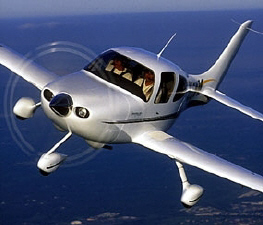 6/08/04: I am now officially a 'CSI', a.k.a. Cirrus Standardized Instructor. Gaining instructional proficiency in the SR-22 has been an interesting challenge. I am impressed by the quality, depth, breadth, and scope of the syllabus. New owners, and rental pilots transitioning into the aircraft, will get a complete and vigorous workout via the standardized transition course. Think of it more like a type rating as opposed to a checkout.
6/08/04: I am now officially a 'CSI', a.k.a. Cirrus Standardized Instructor. Gaining instructional proficiency in the SR-22 has been an interesting challenge. I am impressed by the quality, depth, breadth, and scope of the syllabus. New owners, and rental pilots transitioning into the aircraft, will get a complete and vigorous workout via the standardized transition course. Think of it more like a type rating as opposed to a checkout.
ATP written(s)
6/07/04: My ATP writtens are done - one for airplane, one for helicopter. It took longer than I'd hoped to get them finished, but at least now they're done. I have my sights set on the ATP airplane multiengine practical test. I have compiled an ATP "kit" which I will eventually add to the site - basically I've crawled through the PTS and created a Quick Reference guide that includes practical examples of how to apply the PTS to the ATP practical test. I have flown approximately twenty hours in the PA-30B in preparation for the test, which has been a lot of fun. Thanks to Eric McLeod for his assistance and tutelage.
Latest stuff
5/25/04: Nearly three months since I last updated this site! Wow.
Much has happened. Of most import and interest has been the arrival of my beautiful daughter, Laurel. 9 lbs., 15 oz., May 11, 2004. Daughter and wife are doing great. Having a baby is way cooler than flying... and I'm not kidding!
But, this is a flying site, so on to that.
Right now I'm averaging about 60 flight hours per month as a flight instructor. Instructing is fun, and it's also an important step in my metamorphosis to professional pilot. I've learned so much in the last six months -- and I've caught glimpses of how much more there is to know about the science and art of aviation. I'm still fascinated. I figure, what the hell... if obsessing over flying for four years, and now doing it full time, day in and out, is not enough to burn me out, maybe it'll never happen. That is my current hope and belief.
What's new and interesting? Well, the most common flying I do includes tailwheel/spin/aerobatics training (in Air Orlando's Citabria), providing instruction towards the instrument rating in the Schweizer 300CBi, as well as primary (VFR) instruction in helicopters. I still do primary instruction in airplanes, but since I've started to specialize in the aforementioned areas, I've been trying to limit that.
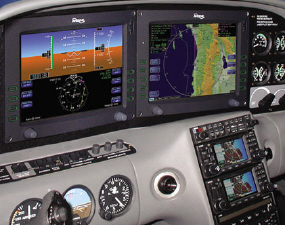 One intriguing new airplane which I've been flying lately is the Cirrus SR-22. It's an (almost) all-glass airplane - PFD, MFD, two Garmin 430s, and an S-TEC 55X autopilot. There are almost no steam gauges to be found in this panel. Overall, I'm quite impressed with the capability of the aircraft and the forethought that went into its design - and the design is getting better over time, by the way.
One intriguing new airplane which I've been flying lately is the Cirrus SR-22. It's an (almost) all-glass airplane - PFD, MFD, two Garmin 430s, and an S-TEC 55X autopilot. There are almost no steam gauges to be found in this panel. Overall, I'm quite impressed with the capability of the aircraft and the forethought that went into its design - and the design is getting better over time, by the way.
The Cirrus experience is very different, from a training perspective. This is simply not an airplane which tolerates a Sunday afternoon checkout. Too different, too complex. Yes, that's right, a
"complicated" single engine, fixed-gear airplane (with a single Power Lever rather than the typical throttle/prop control setup, to boot.) It's a heckuva lotta fun to fly on instruments, though.
Much of the training involves becoming competent, obviously, with the avionics. There is a great deal of both integration, and automation. Becoming proficient with the autopilot and Garmins is a necessity. In fact, in this airplane it is entirely possible to roll onto the runway, rotate, pitch for Vy, punch the autopilot, and not touch the controls again until breaking out at Decision Altitude at your destination airport.
It's also a very slickery airplane, significantly faster even than my beloved Twin Comanche, which is typically about a 160 knot airplane. The Cirrus SR-22 will do every bit of 183 knots in cruise flight. The new G2 (generation 2) model advertises 190. And the gear is welded down... amazing!
When I have completed the transition training and CSIP program (for instructors), I will be a Cirrus Standardized Instructor. Insurance companies demand this designation for new owners seeking instruction in the airplane. I am thankful to Air Orlando for seeing fit to invest in me to the extent of training me to instructional proficiency in the airplane, which is not an inexpensive endeavour.
Finally, the ATP looms. I had hoped to have this one done earlier in the year, but studying for the knowledge test (and preparing for a baby!) has taken quite some time. My current plan is to get the ATP multiengine airplane ride done first, then helicopter ATP, then single-engine airplane. I really do expect that to be the end of the rating roller coaster, except for type ratings in the future. I've actually learned a ton of great stuff working on my ATP, and I've done the training and study almost entirely on my own. I've done all of the flying in my Twin Comanche, which has proven to be a good ship for the rating. An added benefit is that I've learned the aircraft all the more thoroughly by flying to the higher standards and tighter tolerances required by the ATP Practical Test Standards.
That's all for now!
Jiggy
2/29/04: The Citabria in which I now instruct (come see us for tailwheel transition, spin training, unusual attitudes, and aerobatics!) is kept on the east side of the Orlando Executive airport. Air Orlando is on the west side. It's kept on the east ramp because there is no hangar space available near our facility, so as a result I'm bringing it back 'n forth between the two locations on a regular basis. It's about five minute journey on the ground.
At just a few minutes before sunset, I hopped into the airplane to take it back home for the night. The air was crisp and cool; the planes parked on the ramp glowed in the golden twilight. The airport was utterly quiet; no traffic. I called ground control and asked for permission to transition to the east ramp, which was granted. Then I looked at the windsock. It was a left crosswind for 13 (where I was holding short, at the approach end) and a right crosswind for runway 7. Headwind components on both runways. Hmmm...
"Ground, Four Alpha Charlie, I guess I'm feeling a little jiggy tonight... can I amend that request, please? How about a departure off 13, a right 270 back to a long landing on 7, and I can taxi right off the runway onto the highspeed and to the ramp?"
Long pause.
"Okay, Four Alpha Charlie, tower has your request. But she's giving me a blank stare. You might need to run that by her again."
"Roger that." I switched to tower. "Four Alpha Charlie holding short, ready to go at 13," I called.
Tower sounded amused. "Citabria Four Alpha Charlie, been a controller twelve years and I've never given this instruction. Cleared to takeoff runway 13, cleared to land runway 7, long landing approved, taxi to the ramp with me."
Report from the Front
1/23/04: Full time flight instructor and commercial pilot - that's me. Some folks view this as an entry level job which will provide them a stepping stone to something else. For now I'm having too much fun to think about what comes next. I'm simply having a blast.
Any given day will have its own fill of interesting surprises and challenges. One day I received a phone call from a helicopter operator across the field, asking if I could take a customer on a photo flight. Their Robinson was down and the customer had to go now. Great, send him over, I replied. When the customer (a commercial photographer) arrived, I learned that the subject site, a newly constructed office building, was inside Orlando International's (MCO) surface area - about 3 miles north of the control tower! Luckily the winds favored departure to the north that day, so I called Orlando Approach on the phone to see what we could work out. I explained we wanted to orbit at or below 400 feet, about 3 miles north of the airport. "Come on down and we'll try to squeeze you in," the accomodating controller told me.
We took off and headed south - and further south - and we were cleared to enter the Bravo airspace. "Do you see it yet?" I asked my charge anxiously. "It's still further south!" he said. Soon it looked like we were going to enter the airport traffic pattern. At this point it became rather obvious that the customer's ability to pinpoint the site on the sectional was not as good as one might have hoped. Right as my customer got a visual on the site in the distance, approach asked exactly how close to the airport I intended to operate. "Our paperwork says 3 miles north," said the controller. "Ah, sorry about that - looks like our site is about 2 miles north." Approach handed me over to tower, who made it clear he hoped I would not loiter long, and cleared me to continue. Okay, make it 1.5 miles. Tower sounded relieved when I reported that I was on site.
So we orbited there for a good 10-15 minutes at 300-400 feet. And we were called as traffic to every single jet departing the airport. I enjoyed the view of MCO and the jet traffic as the camera clicked away.
And there are random moments which pay dividends to the low-paid instructor. Lifting off with a new pilot in the left seat of a Cessna 172, I was rewarded with the easiest, most natural and genuine laugh I'd heard in a long time. I looked over and saw sheer joy in the eyes of a young man who'd dreamed of flight and was now living that dream. There's no price one can put on that, is there?
 Our flight school has taken delivery of a full motion, six-axis simulator. It is a breathtakingly useful training tool. With the ability to simulate both single and multi-engine light airplanes, I've already been exposed to training that I have only been able to dream about to date. Have you ever wondered how you'd fare with a real (and surprise) engine failure on takeoff between Vmc and Vyse? How about an engine-driven fuel pump or oil pump failure? Flying an approach in an iced-up twin? Asymmetric flap deployment or retraction failures? Faulty gear down indication on a single-engine approach? Runaway trim? Partial panel with REALISTIC vacuum or artificial horizon failure? (You'll be challenged to notice you lost the instrument!) We can literally simulate almost any failure or flight condition you can fathom. The best part? You can log it! Our Fidelity MOTUS, powered by X-plane incidentally, is an FAA-certified Level 3 FTD (Flight Training Device). You can regain your instrument currency, log time towards your instrument rating and commercial certificate, and even take the vast majority of an instrument flight test in this box. It's out of this world.
Our flight school has taken delivery of a full motion, six-axis simulator. It is a breathtakingly useful training tool. With the ability to simulate both single and multi-engine light airplanes, I've already been exposed to training that I have only been able to dream about to date. Have you ever wondered how you'd fare with a real (and surprise) engine failure on takeoff between Vmc and Vyse? How about an engine-driven fuel pump or oil pump failure? Flying an approach in an iced-up twin? Asymmetric flap deployment or retraction failures? Faulty gear down indication on a single-engine approach? Runaway trim? Partial panel with REALISTIC vacuum or artificial horizon failure? (You'll be challenged to notice you lost the instrument!) We can literally simulate almost any failure or flight condition you can fathom. The best part? You can log it! Our Fidelity MOTUS, powered by X-plane incidentally, is an FAA-certified Level 3 FTD (Flight Training Device). You can regain your instrument currency, log time towards your instrument rating and commercial certificate, and even take the vast majority of an instrument flight test in this box. It's out of this world.
It's an exciting place to be. I enjoy being there and look forward to every day I "work." They pay me for this? I can hardly believe it! In line with that, we are bringing a 2001 Citabria Adventure online. I am developing courses for Basic Aerobatics, Spin Training, and Unusual Attitudes/Upset Recovery. There's nothing Air Orlando doesn't offer and I'm awfully proud to be a part of it.
Click here for 2003 updates » (cont'd)
| 
